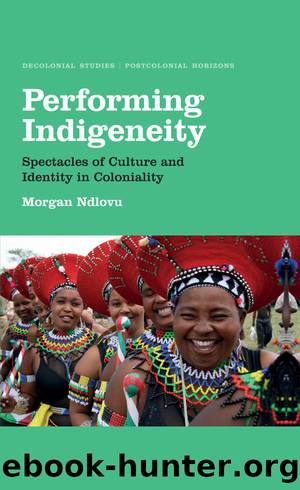Performing Indigeneity by Morgan Ndlovu

Author:Morgan Ndlovu [Ndlovu, Morgan]
Language: eng
Format: epub
ISBN: 9780745338590
Barnesnoble:
Publisher: Pluto Press
Published: 2019-04-15T00:00:00+00:00
Cultural Villages and the Challenge of Reductionist Perspectives
Cultural villages in South Africa are generally popular with both local and international tourists. However, in spite of their popularity, the manner in which they represent culture and identity has attracted a barrage of scholarly criticism (Marschall 2003). In general, the criticism levelled against the villages ranges from the point that they represent myths instead of culture (Tomaselli and Wang 2001) to the claim that they present cultural practices in a romanticized, superficial and ahistorical manner, frozen in time (De la Harpe, De la Harpe, Leitch and Derwe 1999). Moreover, it has been argued that they reproduce stereotypes, generated by the Westâs desire for exoticism and imaginations of the primitive âOtherâ (Jansen van Veuren 2003: 150; see also Craik 1997: 118), and that they treat tourists as if they were for the most part uncritical, passive consumers who enjoy such representations because these confirm touristsâ preconceived stereotypes (Marschall 2003: 110).
In South Africa, cultural villages are heavily criticized for a lack of âobjective authenticityâ and/or their claim to it. Thus, as Jansen van Veuren (2003: 74) has argued:
The question arises to what extent the product of cultural villages consists of indigenous/traditional culture products. Based on observation, it would appear that the cultural village often is built to a larger extent, on an understanding of what Western tourists want, and how best to provide this. Cultural villages as such, are not a form of hospitality or sharing of culture, which exists in indigenous culture, but a construct of Western culture, which probably developed out of early open-air museums. Thus the very concept on which the product is based, the selection of elements from indigenous cultures, and ways in which they are altered and mediated, are all very important inputs into a typical cultural village product, which are based on Western culture.
The above comment suggests that although cultural villages pretend, in their marketing statements, to be sites where indigenous cultures are shared with tourists, they instead conform to the influence of a hegemonic Western world view about the primitive âOtherâ. This becomes problematic because the Western world view about the primitive âOtherâ, which influences the cultural content of the villages, not only carries âmythsâ about the communities whose cultures are claimed to be displayed in an objective way, but also represents a colonization of time and space, since indigenous people are represented as outside of the âhere and nowâ. Thus, because it is not possible to display culture objectively âas it is or was in the pastâ, as culture is neither monolithic nor static, it is problematic for cultural villages to insist that they are displaying true versions of what are supposedly the ways of life by indigenous communities. Doing so is tantamount to imposing and universalizing the views of those who construct them across different people.
The sentiment that cultural villages of South Africa represent a Western imagination of the âOtherâ is also shared by Marschall (2003: 113) in her analysis of the cultural village at PheZulu Safari Park.
Download
This site does not store any files on its server. We only index and link to content provided by other sites. Please contact the content providers to delete copyright contents if any and email us, we'll remove relevant links or contents immediately.
| Africa | Americas |
| Arctic & Antarctica | Asia |
| Australia & Oceania | Europe |
| Middle East | Russia |
| United States | World |
| Ancient Civilizations | Military |
| Historical Study & Educational Resources |
Never by Ken Follett(2880)
The Man Who Died Twice by Richard Osman(2300)
Machine Learning at Scale with H2O by Gregory Keys | David Whiting(2291)
Fairy Tale by Stephen King(2070)
Will by Will Smith(2042)
Rationality by Steven Pinker(1765)
The Dawn of Everything: A New History of Humanity by David Graeber & David Wengrow(1571)
The Dark Hours by Michael Connelly(1570)
Principles for Dealing With the Changing World Order: Why Nations Succeed and Fail by Ray Dalio(1373)
Friends, Lovers, and the Big Terrible Thing by Matthew Perry(1328)
A Short History of War by Jeremy Black(1300)
HBR's 10 Must Reads 2022 by Harvard Business Review(1256)
Go Tell the Bees That I Am Gone by Diana Gabaldon(1234)
Can't Hurt Me: Master Your Mind and Defy the Odds - Clean Edition by David Goggins(1227)
515945210 by Unknown(1208)
Fear No Evil by James Patterson(1109)
443319537 by Unknown(1073)
Works by Richard Wright(1018)
Going There by Katie Couric(991)
